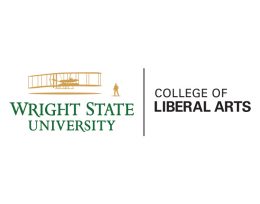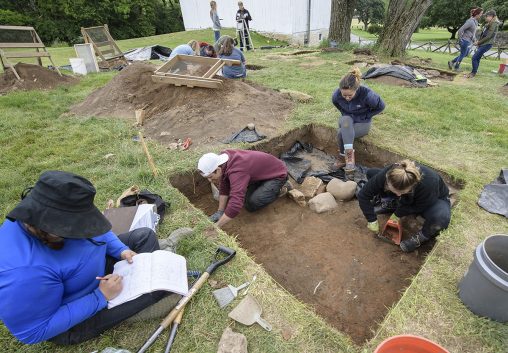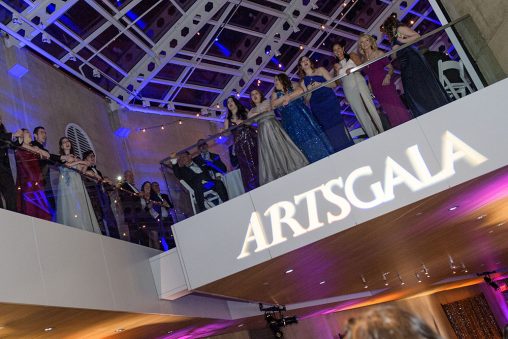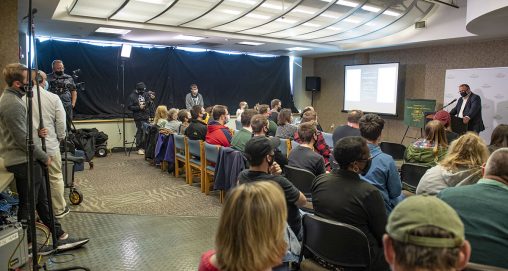 A new administrative structure in the Wright State University College of Liberal Arts promises to facilitate more interdisciplinary learning and teaching and increase opportunities for collaboration among faculty members and students from different disciplines.
A new administrative structure in the Wright State University College of Liberal Arts promises to facilitate more interdisciplinary learning and teaching and increase opportunities for collaboration among faculty members and students from different disciplines.
The College of Liberal Arts has consolidated its 10 departments into three schools: the School of Fine and Performing Arts, the School of Humanities and Cultural Studies, and the School of Social Sciences and International Studies.
Each school is led by a chair and two associate chairs.
The School of Fine and Performing Arts includes the former School of Music, Department of Theatre, Dance and Motion Pictures and the fine arts program.
The School of Humanities and Cultural Studies includes the former departments of English Language and Literatures; History; and Religion, Philosophy and Classics. It also includes the art history program.
The School of Social Sciences and International Studies includes the former School of Public and International Affairs and the departments of Communication, Modern Languages and Sociology and Anthropology.
Existing majors, minors, certificates and courses are not negatively affected by this change. College of Liberal Arts students’ progress to graduation will not be affected by the reorganization of the college.
Restructuring the college’s administrative operations will facilitate more opportunities for students to pursue coursework from other disciplines to broaden their field of study, said Gary Schmidt, Ph.D., dean of the College of Liberal Arts.

The summer Field School in Archaeology offered by the School of Social Sciences and International Studies is one of many experiential learning opportunities available to College of Liberal Arts students.
“It gives them the opportunity to acquire a range of competencies by working with the faculty from different areas, meeting with students from different majors, and engaging with curricular and cocurricular programming from different areas,” he said. “It’s going to help them with their preparation and marketability.”
Providing students with more interdisciplinary offerings will put them in a better position to gain a well-rounded and richly diversified education, said Alpana Sharma, Ph.D., professor of English and chair of the School of Humanities and Cultural Studies.
“Students will also see more team teaching among the faculty; thus, they will benefit from learning from a variety of highly qualified and gifted faculty on a range of topics both informed by the past and relevant to today’s world,” Sharma said.
While many programs have a history of collaboration — for example, international studies and modern languages — the goal of the college’s reorganization is to foster even greater awareness of synergies and new directions, said Laura Luehrmann, Ph.D., professor of political science and chair of the School of Social Sciences and International Studies.
“We are being as intentional as possible in making connections across disciplines and helping our students see the way our areas of expertise come together to help us all understand the complex world we live in,” she said. “By carefully planning our course offerings, co-curricular activities and even collaborative research endeavors, our goal is to provide even more opportunities for our students to pursue their interests and be as prepared as possible for the career opportunities of the future.”
One example of this collaboration is underway, with joint offerings and new tracks in the Master of Public Administration (MPA) program. Beginning this academic year, MPA students will have the choice of three specialized tracks of study: general MPA, criminal justice or social issues.
“With the incorporation of classes from sociology, anthropology, political science and geography, we are able to provide new opportunities to our students to better prepare them for a wide array of careers and experiences,” Luehrmann said.

The School of Fine and Performing Arts will build on the success of ArtsGala, which annually showcases the talents of dance, fine arts, motion pictures, music and theatre students.
Dan Zehringer, D.M.A., professor of music and chair of the School of Fine and Performing Arts, describes the new school as a unification of programs that have many connections, including sharing space in the Creative Arts Center and collaborating on ArtsGala every year.
“Having worked together for so many years, we have a shared history that’s positive and we’re looking to build on that,” he said.
Zehringer said the School of Fine and Performing Arts will initially focus on curricular unification, exploring the creation of new ensembles and combined artistic programming, and using a new shared calendar of events and performances.
One significant collaborative project is the spring theatre production of “On The Town” in the Festival Playhouse. The musical comedy will feature musical theatre and acting students accompanied by a full onstage orchestra with music students and faculty.
Faculty and administrators anticipate that more interdisciplinary collaboration between the schools will lead to new degree programs, minors and certificates. Students are interested in enrolling in innovative programs and the new structure will help facilitate that kind of innovation, Schmidt said.
“It’s about bringing together different approaches to problem-solving, to creativity, to innovation,” he said. “Because every discipline has a particular method, a particular lens. Students can benefit from being exposed to more than just one.”
Sharma said that the programs in the School of Humanities and Cultural Studies have a natural affinity as part of a legacy of education in English, history, religion, philosophy, classics and art history that extends back to Wright State University’s founding in 1967.
“As such, they lend themselves easily to interdisciplinary and cross-disciplinary collaboration as well as showcase what is common to all humanities disciplines: an exploration of the extraordinary diversity of human thought and experience,” she said.
This fall, the school is offering an English course in Native American literature that is cross-listed with the religion program and a faculty member in the history program will teach a course on Napoleon and Russia that is cross-listed with English and several other programs in the college.

This fall, the School of Humanities and Cultural Studies will introduce Prof Talks, a series featuring presentations by faculty members discussing their published work.
On Sept. 2, the school will host a discussion circle in which Sean Pollock, Ph.D., professor of history, will share his current research at the Center for Faculty Excellence.
The school will also introduce a new series, called Prof Talks, featuring faculty presentations on their published work.
“These are some examples of the kind of cross-fertilization we intend to foster in the School of Humanities and Cultural Studies,” Sharma said.
A key to changing the curriculum or collaborating on new programs or projects, Zehringer said, is for everyone in the College of Liberal Arts to get to know each other better.
“Having a reorganized three schools, in the long run, will make us stronger because it will require us to get to know each other and thus be able to come up with new curricular structures that we never had the opportunity to do before,” he said. “Getting to know people, getting to build relationships, building trust with our colleagues and imagining ways in which we can create a better future.”
The new organization also provides an opportunity for faculty, staff and students to create a new vision for the College of Liberal Arts, Schmidt said.
“The liberal arts are so important for our country and our world, for our ability to learn and to change and to work productively with one another,” he said. “And so, we have to first be able to do that in our own unit in order to be models for others.”

 Wright State psychology team studies ways to identify fatigue in pilots, drivers
Wright State psychology team studies ways to identify fatigue in pilots, drivers  Wright State videographer Kris Sproles wins Regional Emmy and Ohio journalism award
Wright State videographer Kris Sproles wins Regional Emmy and Ohio journalism award  Wright State Boonshoft School of Medicine ranked among the nation’s best for 2024 by U.S. News
Wright State Boonshoft School of Medicine ranked among the nation’s best for 2024 by U.S. News  Exposing biotechnology
Exposing biotechnology  Wright State faculty member Dan Noel uses unique background to inspire new leaders
Wright State faculty member Dan Noel uses unique background to inspire new leaders 